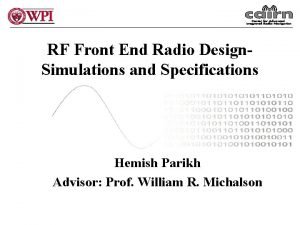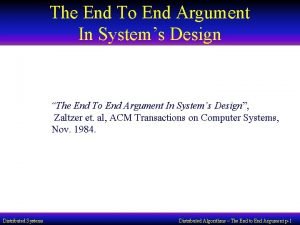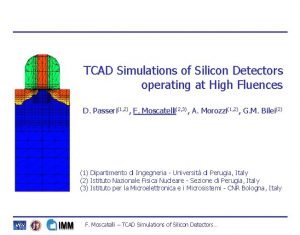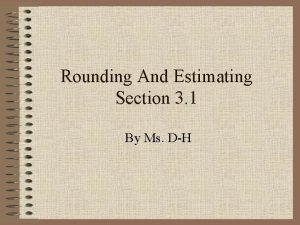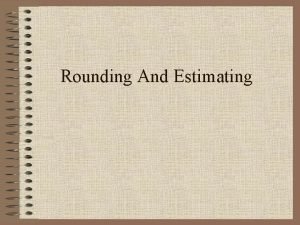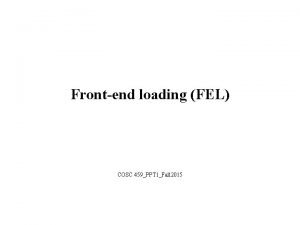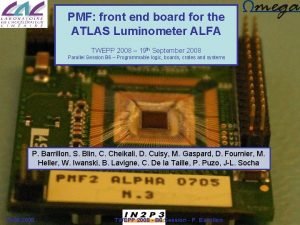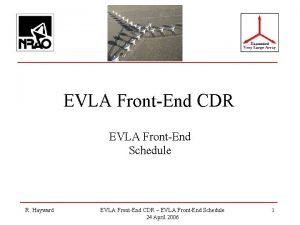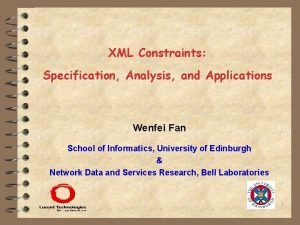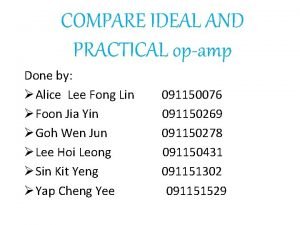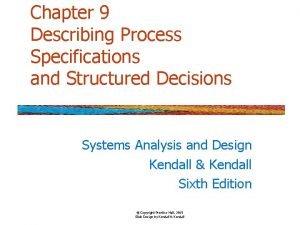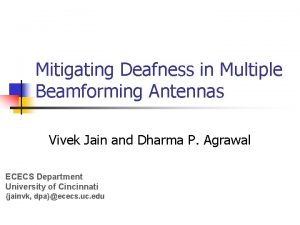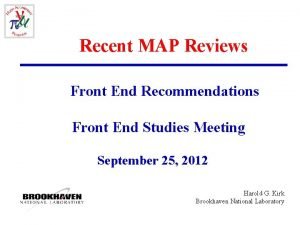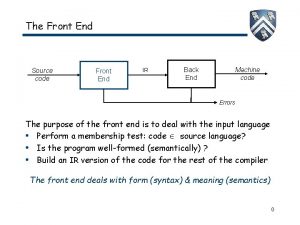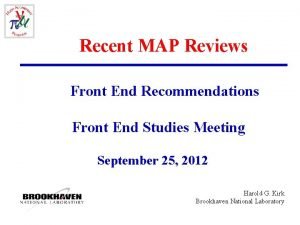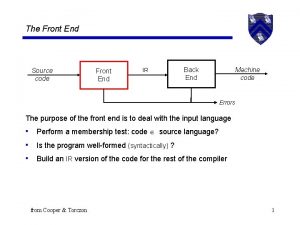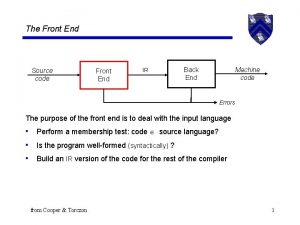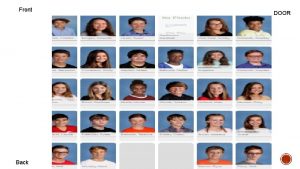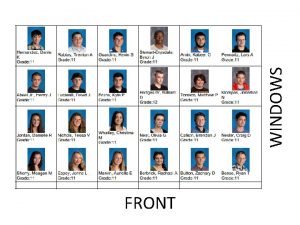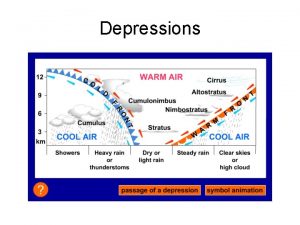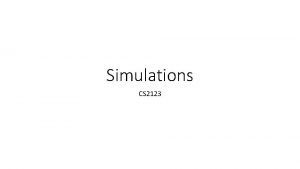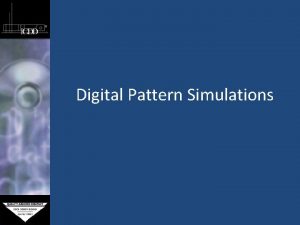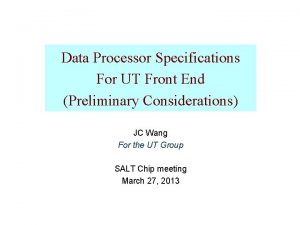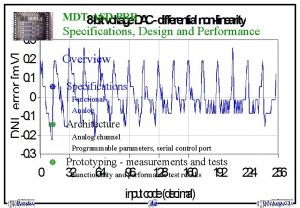RF Front End Radio Design Simulations and Specifications




































- Slides: 36

RF Front End Radio Design. Simulations and Specifications Hemish Parikh Advisor: Prof. William R. Michalson

RF Front End Receiver Design - Outline • • Overview System parameters Specifications System Analysis System Parameter relations System Simulations in ADS Roadmap Questions 12/7/2020 2

RF Front End Receiver Design - Overview You are Here 12/7/2020 3

RF Front End Receiver Design - Overview Possible Front End Models • Model 1: Direct RF Sampling Today’s Focus • Model 2: Direct Down Conversion 12/7/2020 4

RF Front End Receiver Design – System Parameters • • • System Gain (G) System Noise Figure (NF) Input 3 rd Order Intercept Point (IIP 3) Receiver Sensitivity (Rx-Sens) Receiver Spurious Free Dynamic Range (SFDR) • Inter Modulation Distortion (IMD) 12/7/2020 5

RF Front End Receiver Design - Specifications Component Identification RF MICRO DEVICES ANALOG DEVICES RF-2361 AD-8367 COMTELCO ANALOG DEVICES PEXW-400 AD-8343 MURATA 415 -465 MHz 0 -50 MHz VECTRON VARI-L OSC-1 B 0 -10 MHz VCO 190 -445 T ANALOG DEVICES 12/7/2020 ADF-4112 6

RF Front End Receiver Design - Specifications - LNA • RFMD – 2361 – – 12/7/2020 Low Noise Figure (NF): 1. 9 d. B Gain (G): 20 d. B Input 3 rd order intercept point (IIP 3): 6 d. Bm Max input RF level: +10 d. Bm 7

RF Front End Receiver Design - Specifications - AGC • AD 8367: – Variable Gain: -2. 5 d. B to 42. 5 d. B – NF ? ? ? – IIP 3 ? ? ? 12/7/2020 8

RF Front End Receiver Design - Specifications – Mixer (1) LO+RF LO-RF RF LO • • • IM Products Big role in overall system performance Mixing is just frequency shifting Produces LO+RF and LO-RF Produces Unwanted Inter Modulation Distortion (IMD) IM products: (M*LO + N*RF) and (M*LO - N*RF) Good Mixer or a Bad Mixer !!!!!? ? 12/7/2020 9

RF Front End Receiver Design - Specifications – Mixer (2) Good Mixer Low Noise Figure (< 15 d. B) Good Port Isolation (~ 50 d. Bm) 12/7/2020 High IP 3 ( > 15 d. B) High Conversion Gain LO drive level (application dependent) 10

RF Front End Receiver Design - Specifications – Mixer (3) • AD 8343: – – NF: 11 d. B Gain: 7. 1 d. B IIP 3: 20 d. Bm LO drive level: -10 d. Bm 12/7/2020 11

RF Front End Receiver Design - Specifications – Mixer (4) LO = 400 MHz 12/7/2020 12

RF Front End Receiver Design - Specifications - TCXO / VCO • Vectron TCXO: – Frequency: 10 MHz – Stability: 2. 5 ppm – Mechanical Trip: +/- 3 ppm 12/7/2020 • Vari-L VCO: – Tuning Range: 400 to 500 MHz – Tuning Sensitivity: 15 MHz/V 13

RF Front End Receiver Design - Specifications – PLL (1) • ADF 4113: – Programmable counters: P, B, A, R 12/7/2020 14

RF Front End Receiver Design – Analysis System Gain G 1= -2 d. B G 2= 20 d. B G 3= 7. 1 d. B G 4= -2 d. B G(d. B) = G 1+G 2+G 3+G 4 P_in = G + P_out 12/7/2020 BPF LNA MIXER LPF P_in (d. Bm) -40 -42 -22 -14. 9 Gain (d. B) -2 20 7. 1 -2 Cumulative Gain -2 18 25. 1 23. 1 P_out (d. Bm) -42 -22 -14. 9 -12. 9 15

RF Front End Receiver Design – Analysis System Noise Figure (1) Noise Sources System Noise Thermal Noise Figure quantifies how noisy the system is Reference Max allowed NF: Noise Figure is WCDMA: 9 d. B Noise Factor in d. B Cellular: 10 d. B PCS: 6. 8 d. B System noisy due to losses in GOAL: Design receiver circuit, solid state devices. with lowest NF !!!!!! 12/7/2020 16

RF Front End Receiver Design – Analysis System Noise Figure (2) Critical G 1= -2 d. B G 2= 20 d. B G 3= 7. 1 d. B G 4= -2 d. B NF 1=2 d. B NF 2=1. 9 d. B NF 4=11 d. B NF 5= 2 d. B Noise Figure of Cascaded System 12/7/2020 BPF LNA MIXER LPF NF (d. B) 2 1. 9 11 2 Cumulative NF (d. B) 2 3. 9 4. 21 4. 22 17

RF Front End Receiver Design – Analysis System Input IP 3 (1) Third Order products: 2 f 1+f 2, 2 f 1 -f 2, 2 f 2+f 1, 2 f 2 f 1, where f 1 and f 2 are two inputs. IP 3 is a measure of system linearity. Point where the desired signal and the 3 rd order distortion have equal magnitudes. 12/7/2020 Problem: Relatively large magnitude and difficult to filter Reference Min allowed IIP 3: Cellular: -13 d. Bm PCS: -11. 425 d. Bm 18

RF Front End Receiver Design – Analysis System Input IP 3 (2) G 1= -2 d. B IIP 1= d. Bm G 2=20 d. B IIP 2= 6 d. Bm G 3=7. 1 d. B G 4= -2 d. B IIP 3=20 d. Bm IIP 4= d. Bm Critical 12/7/2020 19

RF Front End Receiver Design – Analysis Receiver Sensitivity (1) • Rx. Sens quantifies the receivers ability to respond to weak signal. SNR_min = 12 d. B (Assume) BW = 50 MHz A/D Input Rx. Sens = Noise Floor + 10 log(BW) + SNR_min + Noise Figure 12/7/2020 Rx. Sens = -174 + 77 + 12 + 4. 22 = -80. 78 d. Bm Significantly reduces 20 The Rx. Sens

RF Front End Receiver Design – Analysis Receiver Sensitivity (2) 12/7/2020 As BW increases, sensitivity becomes poor 21

RF Front End Receiver Design – Analysis Receiver Sensitivity (3) 12/7/2020 22

RF Front End Receiver Design – Analysis Receiver Spurious Free Dynamic Range • High DR means Receiver can operate over wide range of input power levels. – Receiver’s Output starts to saturate if the Input is above the range – Below DR, the noise dominates. SFDR = 0. 66 (IIP 3 – Rx. Sens) = 0. 66 (1. 1 + 80. 78) 12/7/2020 = 54. 6 d. B 23

RF Front End Receiver Design – Analysis AGC Issues • Max AGC Gain: – Lowest NF – Lowest IIP 3 12/7/2020 • Min AGC Gain: – High IIP 3 – High NF • Poor Dynamic Range: 25 d. B 24

RF Front End Receiver Design – Parameters Relations System Parameters Relations Higher IP 3 Maximize Rx. Sens Bandwidth Dependent 12/7/2020 Maximize DR Application Dependent Minimize NF 25

RF Front End Receiver Design - Simulations ADS simulations for Gain (1) 12/7/2020 26

RF Front End Receiver Design - Simulations ADS simulations for Gain (2) Swapped 12/7/2020 27

RF Front End Receiver Design - Simulations ADS simulations for NF(1) 12/7/2020 28

RF Front End Receiver Design - Simulations ADS simulations for NF(2) Swapped 12/7/2020 29

RF Front End Receiver Design - Simulations ADS simulations for IMD (1) 12/7/2020 30

RF Front End Receiver Design - Simulations ADS simulations for IMD (2) 12/7/2020 31

RF Front End Receiver Design - Simulations ADS simulations for IMD (3) 12/7/2020 32

RF Front End Receiver Design - Simulations ADS simulations for SFDR Rx Signal Level = -25 d. Bm SFDR ~= 50 d. B SFDR 12/7/2020 33

RF Front End Receiver Design - Simulations 12/7/2020 34

RF Front End Receiver Design Roadmap • • ADS with Matlab ADS with Instruments Set-up Evaluation board Migrate to 2. 4 GHz 12/7/2020 35

RF Front End Receiver Design ? 12/7/2020 36
 Front end of compiler
Front end of compiler Back end of the compiler includes
Back end of the compiler includes Rf front end receiver design
Rf front end receiver design End to end argument
End to end argument Don't gamble with physical properties for simulations
Don't gamble with physical properties for simulations Clinical simulations in nursing education
Clinical simulations in nursing education Chris harding simulations
Chris harding simulations Tcad simulations
Tcad simulations World history simulations
World history simulations Simulations for solid state physics
Simulations for solid state physics Www.irs.gov/app/understanding taxes/student/simulations.jsp
Www.irs.gov/app/understanding taxes/student/simulations.jsp Key tenets of ippd
Key tenets of ippd Baton simulations
Baton simulations Food product development brief template
Food product development brief template Occluded front images
Occluded front images Awin support
Awin support Dead front vs live front transformer
Dead front vs live front transformer How to make school magazine cover page
How to make school magazine cover page Front-end rounding
Front-end rounding Front-end rounding
Front-end rounding Front end loading
Front end loading Front end board
Front end board Snort front end
Snort front end Forced connections examples
Forced connections examples Front end schedule
Front end schedule Front end inspection
Front end inspection Front end stage
Front end stage Xml constraints
Xml constraints Compare ideal op-amp and practical op-amp
Compare ideal op-amp and practical op-amp Describe the process specification structured decisions
Describe the process specification structured decisions Stroke volume units
Stroke volume units Preload stroke volume
Preload stroke volume Descendorektostomie
Descendorektostomie Yichao zhou
Yichao zhou End to end accounting life cycle tasks
End to end accounting life cycle tasks Protect
Protect End to end delay
End to end delay


